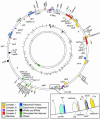Sequence and comparative analysis of the maize NB mitochondrial genome
- PMID: 15542500
- PMCID: PMC527149
- DOI: 10.1104/pp.104.044602
Sequence and comparative analysis of the maize NB mitochondrial genome
Abstract
The NB mitochondrial genome found in most fertile varieties of commercial maize (Zea mays subsp. mays) was sequenced. The 569,630-bp genome maps as a circle containing 58 identified genes encoding 33 known proteins, 3 ribosomal RNAs, and 21 tRNAs that recognize 14 amino acids. Among the 22 group II introns identified, 7 are trans-spliced. There are 121 open reading frames (ORFs) of at least 300 bp, only 3 of which exist in the mitochondrial genome of rice (Oryza sativa). In total, the identified mitochondrial genes, pseudogenes, ORFs, and cis-spliced introns extend over 127,555 bp (22.39%) of the genome. Integrated plastid DNA accounts for an additional 25,281 bp (4.44%) of the mitochondrial DNA, and phylogenetic analyses raise the possibility that copy correction with DNA from the plastid is an ongoing process. Although the genome contains six pairs of large repeats that cover 17.35% of the genome, small repeats (20-500 bp) account for only 5.59%, and transposable element sequences are extremely rare. MultiPip alignments show that maize mitochondrial DNA has little sequence similarity with other plant mitochondrial genomes, including that of rice, outside of the known functional genes. After eliminating genes, introns, ORFs, and plastid-derived DNA, nearly three-fourths of the maize NB mitochondrial genome is still of unknown origin and function.
Figures






References
-
- Altschul SF, Gish W, Miller W, Myers EW, Lipman DJ (1990) Basic local alignment search tool. J Mol Biol 215: 403–410 - PubMed
-
- Backert S, Nielsen BL, Börner T (1997) The mystery of the rings: structure and replication of mitochondrial genomes from higher plants. Trends Plant Sci 2: 477–484
-
- Bendich AJ (1993) Reaching for the ring: the study of mitochondrial genome structure. Curr Genet 24: 279–290 - PubMed
Publication types
MeSH terms
Substances
Associated data
- Actions
- Actions
LinkOut - more resources
Full Text Sources
Other Literature Sources
Molecular Biology Databases

